Colin Griffith has been in homoeopathic practice for 25 years. He is a founding member of the longstanding proving circle started by Janice Micallef in 1990, whose members included the late Martin Miles who contributed so much to the life of new remedies and new ways of prescribing. Colin has taught homoeopathy for almost as long as he has practised it and has lectured in America, Canada, Japan, Greece, Spain, Ireland and the UK. He runs a busy mixed practice in Kent along with two of his children who have followed him into alternative therapy.

CONTENTS ACKNOWLEDGEMENTS The volumes of the
New Materia Medica and this Repertory owe their existences to many people. First among them is Janice Micallef who is the inspiration, leader and medium behind the several meditation circles that have spent nearly a quarter of a century in proving the remedies.
Without her, very few of these nearly 100 remedies now in use would be available. We are in debt to Jill Wright who spent long hours transcribing all the recordings and typing up the transcripts of the provings thus making the work of putting them into book form possible. The members of the circle for the past 10 years are: Jill Wright, Sylvia Treacher, Sue Baker, Jennifer Maughan, Jerome Whitney, Maggie Gravells, Lesley Suter, Lisa Cosso, Maureen Rose, Graham Martin and myself. Nick Griffith, Edo Cosso and Peter Firebrace have occasionally added their energies to the circle. The late Martin Miles was also with us until his passing in 2008. (His last inspiration for us was Blackbird Song see Appendix 3.) The circle meets every two months; the members efforts in getting to the meetings children, distance, practice et al notwithstanding are remarkable.
Fiona Spencer-Thomas, my homoeopathically trained agent, is as ever a wonderful support. She believes wholeheartedly in these medicines and is a passionate advocate of their use. Without her input this book would not have come to light. This is also very true of Michael Mann, publisher extraordinary of alternative books. Long may he continue to be a force for such good. Profound thanks to them both.
My wife, Sofi, and our children have prodigious amounts of patience for which I am so very grateful; I have not been easy to live with while putting the Repertory together. The work has been painstaking not like the broad sweep of the Materia Medicas at all; the concentration levels required have caused many moments of hurried, hushed conversation and uncustomary tiptoeing in and out of the house. *** This book is dedicated to Jill Wright, scribe for the circle and archivist of the provings, without whose invaluable efforts on our behalf very few of the remedies and nothing at all of the repertory would have seen the light of day. INTRODUCTION THE REASON FOR A REPERTORY FOR THE NEW REMEDIES This repertory was inspired by the pleas of practitioners who have been using the remedies found in the New Materia Medica with enthusiasm but struggling with searching in the new materia medicas without the benefit of a symptom guide. The complaint of many homoeopaths was that they found they had been using only a limited number of the dozens of remedies those that had become familiar from lectures and practical experience or that they had taken themselves in their own healing journey. It is only through writing this book that I realise how much my own use of the remedies has been limited to those that have meant most to me personally; writing the book has taught me a lot more about the remedies on which I based two volumes! As I passionately believe in the value and efficacy of all of these new medicines even those I have neglected in my own practice I hope that this reference book helps practitioners in their selection of like remedies.
THE TROUBLE WITH REPERTORIES In college we are taught to regard the repertory as indispensable, but homoeopathic repertories are imperfect books; they contain information that is not found in the various materia medicas and they leave out important symptoms that are. This situation has been partly addressed but also exaggerated by all the publications of additions that have become available in the last 30 years. We now have an even greater task in differentiating between the vastly expanded lists of possible remedies. Now, here is another repertory to add to the already groaning shelf for those who wish to explore new ways of looking into old problems. This book is as much at fault as any other of its kind so a word of explanation. This repertory is based on the materia medica of remedies proved through meditation practice.
Though they have been in use for more than two decades in some cases and many practitioners feel completely attuned to those they use often there is still more work to be done on each of them; they need to earn and keep earning their right to be in the homoeopathic pharmacy. I have been acutely conscious of the unconventional and exclusively empirical nature of the method of proving so I would ask you to bear in mind that for all the professional integrity of the provers and early users of the remedies, there is still a need to make your selection with the combined use of both the repertory and materia medica however much intuition plays a part in your practice and a comparison with old friends. USING NEW REMEDIES FOR SERIOUS PATHOLOGY All this becomes of particularly sharp significance when prescribing for patients with serious pathology. By adding a remedy to a rubric, a claim is being made for it. Where such conditions as AIDS, cancer, heart disease and others with all the hefty connotations they carry are concerned, it is essential not to rely on just one repertory or one materia medica unless or until your certainty is borne out of previous positive experience (only gained by confidence in taking untried measures) and a clear likeness between remedy and case. Please note that in some cases where a remedy is cited in a rubric, it might be described in the materia medica as being one to consider in this or that condition or words to this effect.
Note the lack of certitude, but also the invitation to compare the general likeness. Though difficult and even threatening pathology has undoubtedly been positively influenced by these new remedies as some of the cases related in the materia medicas show it is vital to be thoroughly discriminating in making your selection of the similimum, even if frustration with the less than satisfactory results of using familiar remedies makes you sure you must look for fresh options and inspiration. NEW REMEDIES CANNOT REPLACE OLD FRIENDS It is my belief that the new remedies are additions, not usurpers of older, sovereign remedies. To ensure that no one is tempted to use this book to the exclusion of others, I have offered the reader a selection of comparable old remedies after each rubric. All those remedies appearing in smaller type within brackets are taken from Murphys repertory. For the most part I have edited each list, leaving out any remedy that is clearly nothing like any of the new remedies within the rubric, even those that appear in black type in Murphys.
On some occasions, however, I have cited remedies that do not have much in common with the new remedies in the rubric. These old remedies are so strongly indicated in the problem that they cannot be left out of any consideration. Our responsibility to patients is too great not to have a balanced approach to our selection process. My choices of comparison remedies may be lacking in insight or biased in favour of remedies I know really well so if you are in any doubt, do your own research. Having said all this, it has become increasingly clear over the last 20 and more years that the new remedies have become so popular because of a) their ability to peel back layers of problems that prevent familiar remedies from doing their work; b) the way that they cover particular, peculiar, deeper and unfamiliar aspects of familiar territory; c) their value as journey remedies: intercurrent remedies that open up areas of the psyche hitherto closed, hidden or buried in history. Experience has shown that by using new remedies especially when indicated old ones have failed or have helped only partially difficult cases are able to progress with the healing taking on deeper and usually historical or even ancestral significance.

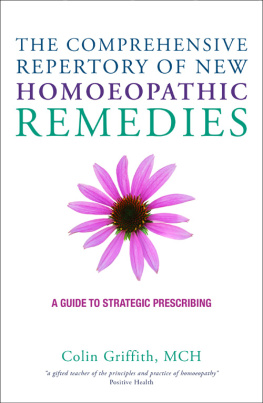
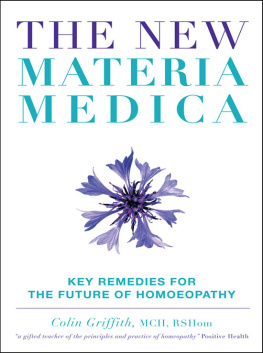
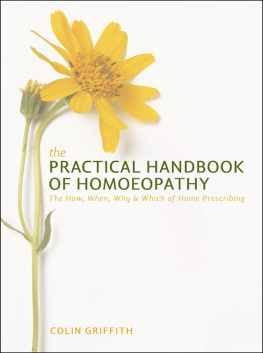

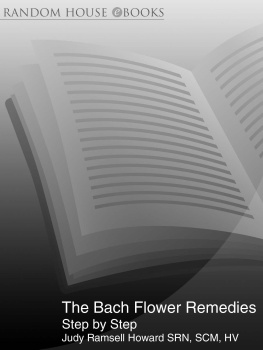
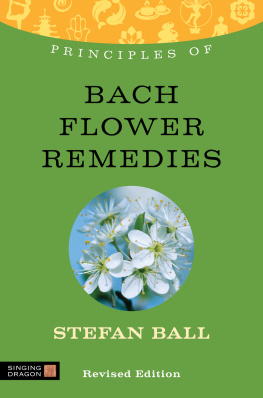


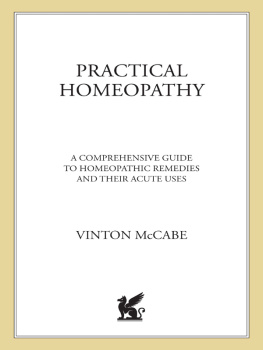
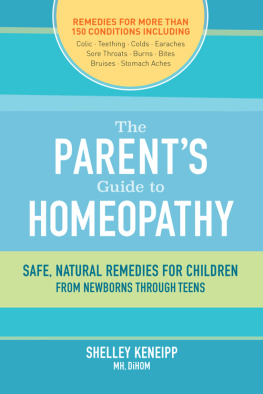
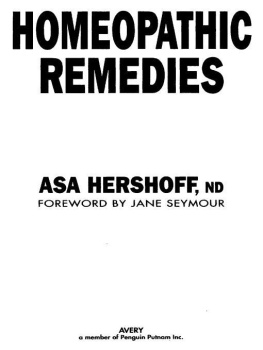
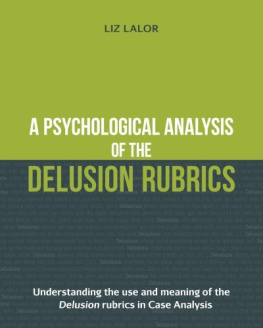
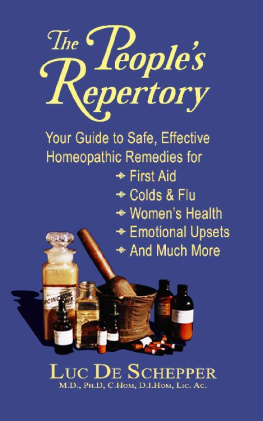

 CONTENTS ACKNOWLEDGEMENTS The volumes of the New Materia Medica and this Repertory owe their existences to many people. First among them is Janice Micallef who is the inspiration, leader and medium behind the several meditation circles that have spent nearly a quarter of a century in proving the remedies.
CONTENTS ACKNOWLEDGEMENTS The volumes of the New Materia Medica and this Repertory owe their existences to many people. First among them is Janice Micallef who is the inspiration, leader and medium behind the several meditation circles that have spent nearly a quarter of a century in proving the remedies.